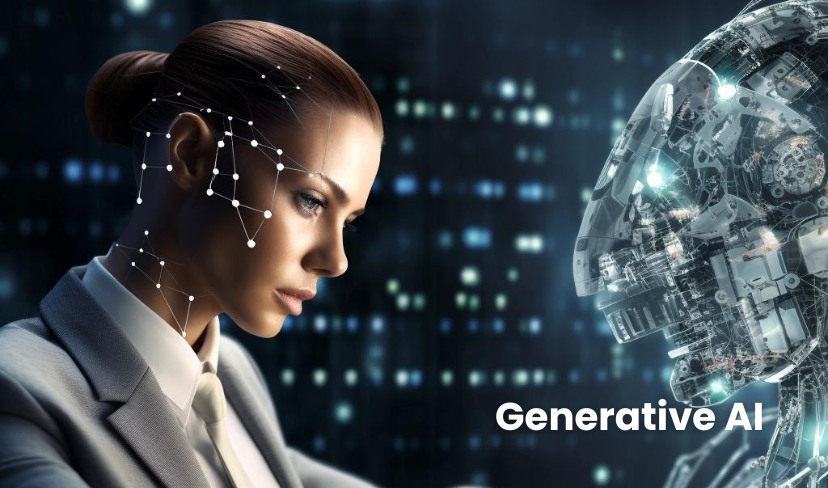“Generative AI and cybersecurity engage in an ongoing game of cat-and-mouse.“
Let’s find out!
In today’s world, cybersecurity is of utmost importance. With the increasing number of cyberattacks, it is essential to have a robust cybersecurity system in place. One of the most promising technologies that can help fortify your company’s digital defences is Generative AI. It is an advanced technology that can adapt to evolving hacker tactics and amplify risk and resilience. In this blog post, we will explore what Generative AI is, how it can fortify your company’s digital defences and its pivotal role in cybersecurity. We will also discuss the future landscape of AI in cybersecurity and how Transputec’s Cyber Security Offering relates to Generative AI.
What is Generative AI
Generative AI (GenAI), short for Generative Adversarial Intelligence, is a subset of artificial intelligence that focuses on creating new content, be it images, text, or even security measures. Unlike traditional AI systems, which rely on pre-programmed rules, Generative AI learns from data, adapting and evolving its responses over time. This dynamic nature makes it an ideal candidate for enhancing cybersecurity.
Pivotal Role of AI in Cybersecurity
Artificial Intelligence (AI) is playing a significant role in cybersecurity. AI allows machines to perform tasks that typically require human intelligence, such as decision-making, speech recognition, image recognition, and language translation. By using training data, AI can understand the context and determine how to react or respond in different situations. It can automate jobs and make decisions faster than humans ever could. Additionally, AI can analyse user behaviour on a larger scale and at a faster pace.
AI technology in cybersecurity uses machine learning and other techniques to enhance security measures by detecting anomalies, automating routine tasks, and improving threat intelligence. It can assist analysts in identifying attacks faster and predicting future threats. This allows cybersecurity professionals to anticipate threats before they happen and make the most of their existing security tools.
How does Generative AI fortify digital defences
Generative AI is a promising technology that can help fortify your company’s digital defences. According to a report by Bain & Company, generative AI should strengthen cybersecurity, particularly in threat identification, although it’s unlikely to lead to full automation anytime soon. It can also be used to automate security operations, particularly routine tasks such as patch management and vulnerability scanning, allowing security teams to focus on more complex issues. Besides, it can significantly assist in improving threat intelligence thanks to its ability to quickly analyse the data. Through a range of moves today, both buyers and providers of cybersecurity services can take advantage of the new technology while remaining protected.
However, it is important to note that generative AI-assisted dangers include strains of malware that self-evolve, creating variations to attack a specific target with a unique technique, payload, and polymorphic code that’s undetectable by existing security measures. Only the most agile cybersecurity operations will stay ahead.
How Generative AI amplifies risk and resilience

Generative AI introduces a dual dynamic to cybersecurity by amplifying risks through increased sophistication and adaptability of cyber threats, while simultaneously enhancing resilience through predictive analysis, adaptive defence mechanisms, and reduced response times. Organisations must carefully navigate this landscape, integrating Generative AI into a comprehensive cybersecurity strategy to achieve optimal risk management and resilience against evolving cyber threatsIt’s crucial to understand how Generative AI can both amplify risk and enhance resilience for organisations. Let’s explore how Generative AI affects risk and resilience:
Increased Sophistication of Cyber Threats
Generative AI’s ability to generate new content and responses means that cyber threats become more sophisticated. Hackers can leverage AI to create realistic phishing emails, deepfakes, and other deceptive techniques that traditional security measures might struggle to detect.
Adaptation to Evolving Tactics
As Generative AI adapts to evolving hacker tactics, the risk landscape amplifies due to the potential for rapid changes in attack strategies. Cyber adversaries can leverage these adaptive technologies to stay ahead of traditional security protocols, posing a heightened risk to organisations.
Potential for Autonomous Attacks
Generative AI has the potential to be used in autonomous cyber attacks. As the technology becomes more sophisticated, there is a risk that AI-powered attacks could operate independently, identifying vulnerabilities, exploiting them, and adapting to countermeasures in real time.
Predictive Threat Analysis
Generative AI’s strength lies in its predictive capabilities. By analysing historical data and identifying patterns, it can predict potential threats before they materialise. This proactive approach enables organisations to strengthen their defences in anticipation of emerging risks.
Adaptive Defense Mechanisms
Generative AI adapts its defence mechanisms based on the evolving threat landscape. This adaptability ensures that the organisation’s defence strategies remain effective against new and unknown threats. The ability to dynamically adjust security protocols contributes significantly to organisational resilience.
Reduced Time to Respond
The predictive nature of Generative AI reduces the time it takes to respond to potential threats. By identifying anomalies and predicting malicious activities, organisations can take swift action, minimising the impact of cyber-attacks and enhancing overall resilience.
Continuous Learning and Improvement
Generative AI’s continuous learning capabilities contribute to a balanced approach. While it amplifies certain risks, its ability to continuously improve and adapt enhances an organisation’s overall resilience. The key is to leverage GenAI as part of a comprehensive cybersecurity strategy that addresses both current and emerging threats.
Human-Machine Collaboration
Their role in cybersecurity is most effective when combined with human expertise. Human analysts can provide contextual understanding, ethical considerations, and strategic insights that complement the algorithmic capabilities of Generative AI. This collaboration ensures a holistic approach to cybersecurity, striking a balance between risk mitigation and organisational resilience.
The Main Benefit of Generative AI
The primary advantage of GenAI in cybersecurity is its predictive capabilities. By analysing patterns and learning from historical data, it can anticipate potential threats before they materialise. This shift from a reactive to a proactive approach is a game-changer in the world of digital security. Other benefits are:
| Automated security operations | It can help automate security operations, particularly routine tasks such as patch management and vulnerability scanning, allowing security teams to focus on more complex issues. |
| Improved threat intelligence | It can significantly assist in improving threat intelligence thanks to its ability to quickly analyse the data. |
| Faster incident response | IT can help analysts spot an attack faster, and then better assess its scale and potential impact. For instance, it can help analysts more efficiently filter incident alerts, rejecting false positives |
| Predictive threat analysis | IT can learn from patterns found in cyber threats or vulnerabilities, resulting in the ability to predict future threats. Rather than responding to threats as they occur, cybersecurity professionals could leverage them to anticipate threats before they materialise and to maximise the value of their existing security tools. |
The Future Landscape of AI in Cybersecurity
The future of AI in cybersecurity is promising. AI is expected to have a profound influence on the cybersecurity landscape in the coming years. AI-powered security solutions can analyse vast amounts of data in real time, identify patterns that may indicate an attack, and generate automated responses to mitigate the threat. AI can also learn from patterns found in cyber threats or vulnerabilities, resulting in the ability to predict future threats. Rather than responding to threats as they occur, cybersecurity professionals could leverage AI to anticipate threats before they materialise, and to maximise the value of their existing security tools. However, it is important to note that cyberattacks are constantly evolving, and new technologies are being developed to combat them. Therefore, it is essential to stay up-to-date with the latest cybersecurity trends and technologies.
Adopting GenAI in Cybersecurity: Transputec’s Offering
Transputec is a leading IT services provider that acknowledges the transformative potential of Generative AI in cybersecurity. They offer a comprehensive range of cybersecurity services that can help strengthen your company’s digital defences. Transputec uses the power of Generative AI and machine learning algorithms to optimise processes and drive efficiencies. By automating repetitive tasks and streamlining operations, Transputec’s AI solutions enable organisations to increase productivity, reduce costs, and stay ahead in today’s competitive landscape. Furthermore, it can significantly aid in improving threat intelligence by quickly analysing data. Transputec’s Cyber Security Offering can use Generative AI to enhance its services and provide a more robust cybersecurity solution to its clients.
Conclusion
In navigating the ever-evolving landscape of cybersecurity, our exploration into the realm of Generative AI has uncovered a transformative force at the forefront of digital defence. We’ve witnessed how Generative AI, with its ability to adapt, learn, and predict, plays a pivotal role in fortifying organisations against the escalating sophistication of cyber threats. From its predictive capabilities to the dual dynamic of risk amplification and resilience enhancement, Generative AI emerges as a beacon of hope in the ongoing battle against cyber adversaries.
As we embrace advanced technologies such as AI, automated botnets, IoT, and cloud computing, the importance of finding a delicate balance between risk and resilience becomes evident. The collaboration between Generative AI’s continuous learning and human expertise marks a strategic approach to cybersecurity, promising not only defence against current threats but also preparedness for those yet to emerge. Transputec, a leader in IT services, stands ready to assist you on this transformative journey. Our tailored solutions leverage Generative AI to provide adaptive defences, predictive threat analysis, and a resilient security posture.
Contact us today to connect with our experts, explore the potential of Generative AI, and discuss how Transputec’s innovative solutions can empower your business in the dynamic landscape of cyber threats. Your digital security is our priority, and we look forward to helping you build a robust defence against evolving challenges.
FAQs
Q1: How does Generative AI differ from traditional cybersecurity measures?
Generative AI differs by dynamically adapting to evolving threats, whereas traditional measures rely on static rules.
Q2: Can Generative AI protect against unknown threats?
Yes, Generative AI excels in predicting and defending against both known and unknown threats through continuous learning.
Q3: How does Transputec integrate Generative AI into cybersecurity solutions?
Transputec integrates Generative AI into its cybersecurity offerings, providing clients with adaptive defences, predictive threat analysis, and resilient security measures.







